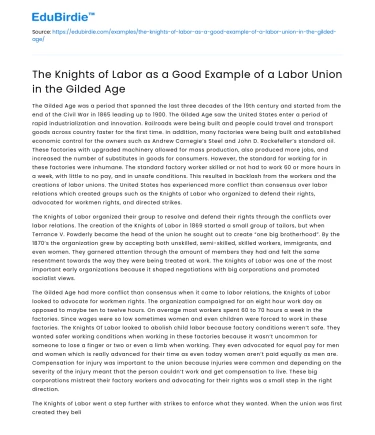The Gilded Age was a period that spanned the last three decades of the 19th century and started from the end of the Civil War in 1865 leading up to 1900. The Gilded Age saw the United States enter a period of rapid industrialization and innovation. Railroads were being built and people could travel and transport goods across country faster for the first time. In addition, many factories were being built and established economic control for the owners such as Andrew Carnegie’s Steel and John D. Rockefeller’s standard oil. These factories with upgraded machinery allowed for mass production, also produced more jobs, and increased the number of substitutes in goods for consumers. However, the standard for working for in these factories were inhumane. The standard factory worker skilled or not had to work 60 or more hours in a week, with little to no pay, and in unsafe conditions. This resulted in backlash from the workers and the creations of labor unions. The United States has experienced more conflict than consensus over labor relations which created groups such as the Knights of Labor who organized to defend their rights, advocated for workmen rights, and directed strikes.
The Knights of Labor organized their group to resolve and defend their rights through the conflicts over labor relations. The creation of the Knights of Labor in 1869 started a small group of tailors, but when Terrance V. Powderly became the head of the union he sought out to create “one big brotherhood”. By the 1870’s the organization grew by accepting both unskilled, semi-skilled, skilled workers, immigrants, and even women. They garnered attention through the amount of members they had and felt the same resentment towards the way they were being treated at work. The Knights of Labor was one of the most important early organizations because it shaped negotiations with big corporations and promoted socialist views.
Save your time!
We can take care of your essay
- Proper editing and formatting
- Free revision, title page, and bibliography
- Flexible prices and money-back guarantee
The Gilded Age had more conflict than consensus when it came to labor relations, the Knights of Labor looked to advocate for workmen rights. The organization campaigned for an eight hour work day as opposed to maybe ten to twelve hours. On average most workers spent 60 to 70 hours a week in the factories. Since wages were so low sometimes women and even children were forced to work in these factories. The Knights Of Labor looked to abolish child labor because factory conditions weren’t safe. They wanted safer working conditions when working in these factories because it wasn’t uncommon for someone to lose a finger or two or even a limb when working. They even advocated for equal pay for men and women which is really advanced for their time as even today women aren’t paid equally as men are. Compensation for injury was important to the union because injuries were common and depending on the severity of the injury meant that the person couldn’t work and get compensation to live. These big corporations mistreat their factory workers and advocating for their rights was a small step in the right direction.
The Knights of Labor went a step further with strikes to enforce what they wanted. When the union was first created they believed in boycotts and arbitrations and Terrance Powderly had little to no control over the union as he only overlooked union membership. However, despite disliking strikes they had success against the Union Pacific Railroad in 1884 and the Wabash Railroad in 1885. It wasn’t until 1877 with the failure of the Great Railroad Strike that they realized they needed to be more organized. With these strikes the Knights of Labor saw their amount of memberships go through the roof, claiming around 700,000 members by the mid 1880’s. soon after in 1886 with Jay Gould’s rail company, after a union worker was fired for attending a union meeting many others simply just walked off the job and soon many others did too. Strikes proved their resentment towards the owners and it only gained them negative headlines. Membership plummeted after the Haymarket Riot in Chicago on may 1st, 1886 where at least 7 Police officers were killed by a bomb. 4 out of the 8 accused were hanged and one committed suicide. After this incident the union was disbanded, but other non-violent unions were formed and picked up the same socialist views.
In conclusion, the Knights of Labor experienced more conflict than consensus over labor relations. This group was a good example of a labor union who expressed resentment towards the labor relations they had to deal with. The Knights of Labor were organized and didn’t focus on race or sexuality, they advocated their ideas, and showed a little force through their strikes. Although the union saw some success and eventually collapsed near then end of the 1880’s, they paved the way for other union groups to adopt similar socialistic views. Through their hard work of these labor unions social policies were eventually adopted and became laws.






 Stuck on your essay?
Stuck on your essay?

